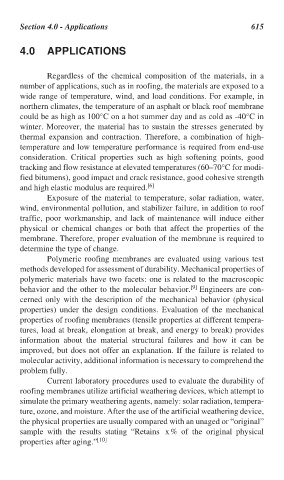Page 647 - Handbook of Thermal Analysis of Construction Materials
P. 647
Section 4.0 - Applications 615
4.0 APPLICATIONS
Regardless of the chemical composition of the materials, in a
number of applications, such as in roofing, the materials are exposed to a
wide range of temperature, wind, and load conditions. For example, in
northern climates, the temperature of an asphalt or black roof membrane
could be as high as 100°C on a hot summer day and as cold as -40°C in
winter. Moreover, the material has to sustain the stresses generated by
thermal expansion and contraction. Therefore, a combination of high-
temperature and low temperature performance is required from end-use
consideration. Critical properties such as high softening points, good
tracking and flow resistance at elevated temperatures (60–70°C for modi-
fied bitumens), good impact and crack resistance, good cohesive strength
and high elastic modulus are required. [6]
Exposure of the material to temperature, solar radiation, water,
wind, environmental pollution, and stabilizer failure, in addition to roof
traffic, poor workmanship, and lack of maintenance will induce either
physical or chemical changes or both that affect the properties of the
membrane. Therefore, proper evaluation of the membrane is required to
determine the type of change.
Polymeric roofing membranes are evaluated using various test
methods developed for assessment of durability. Mechanical properties of
polymeric materials have two facets: one is related to the macroscopic
behavior and the other to the molecular behavior. [9] Engineers are con-
cerned only with the description of the mechanical behavior (physical
properties) under the design conditions. Evaluation of the mechanical
properties of roofing membranes (tensile properties at different tempera-
tures, load at break, elongation at break, and energy to break) provides
information about the material structural failures and how it can be
improved, but does not offer an explanation. If the failure is related to
molecular activity, additional information is necessary to comprehend the
problem fully.
Current laboratory procedures used to evaluate the durability of
roofing membranes utilize artificial weathering devices, which attempt to
simulate the primary weathering agents, namely: solar radiation, tempera-
ture, ozone, and moisture. After the use of the artificial weathering device,
the physical properties are usually compared with an unaged or “original”
sample with the results stating “Retains x% of the original physical
properties after aging.” [10]

